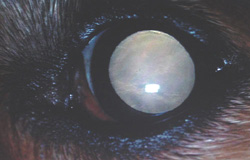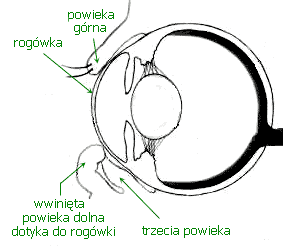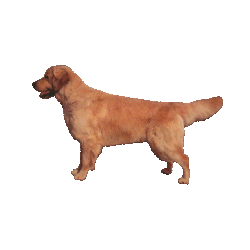
- Progressive Retinal Atrophy (PRA)
- Cataracts
- Eyelid Malformation (Entropion)
- Corneal Dystrophy
Currently, there is no organization in Poland dedicated to addressing inherited eye diseases in dogs. The Polish Kennel Club, which has been in existence for years, does not engage in such activities nor does it require ocular examinations for dogs intended for breeding. Therefore, the information in this text is based on sources from the United States and the United Kingdom.
Progressive Retinal Atrophy (PRA)
General Information:
The retina is responsible for receiving incoming light stimuli and transforming them into nerve impulses, which are transmitted through the optic nerve to the visual center in the brain. This organ is located in the posterior part of the eye and consists of ten different layers. The first nine layers (closer to the inner eye) make up the neuroretina, which contains special light-sensitive cells called rods (for night vision) and cones (for daytime vision). The tenth layer (outermost) is the retinal pigment epithelium (RPE).
Each cone or rod contains a photoreceptor, which is a structure that directly receives light stimuli. The RPE is responsible for actively destroying worn-out photoreceptors and producing new ones.
Progressive retinal atrophy, also known as progressive retinal degeneration (PRD), is a long-known hereditary eye disorder that occurs in many dog breeds.

In reality, the term PRA now encompasses many different types of retinal degeneration occurring in many dog breeds. In Golden Retrievers, two common forms are:
- Central Progressive Retinal Atrophy (cPRA), more correctly known as Retinal Pigment Epithelial Dystrophy (RPED). The change in terminology from cPRA to RPED is due to the discovery that cPRA is caused by dysfunction in the retinal pigment epithelium (RPE).
- Generalized Progressive Retinal Atrophy (gPRA).
RPED primarily occurs in dogs in the UK and Europe, while it is relatively rare in the USA. RPED is characterized by the active destruction of worn-out photoreceptors and the failure to replace them with new ones, leading to the gradual degeneration of both cones and rods in the central part of the retina. This results in a loss of central vision while peripheral vision remains intact.
The disease process usually begins at 3-4 months of age, with the first visible changes in the retina appearing around 12-18 months of age. In some cases, the condition may not be diagnosed until the dog is 8-9 years old.
gPRA (generalized PRA; progressive rod-cone degeneration with later onset) involves the destruction of photoreceptors due to biochemical disturbances occurring within the light-sensitive cells of the neuroretina. Initially, the rods’ photoreceptors degenerate, causing night blindness. Dogs affected by gPRA may show reluctance to move in dark areas, exhibit signs of disorientation, and seek close contact with their owner. As the disease progresses, the cones also degenerate, leading to complete blindness, typically between 3-6 years of age. However, blind dogs can adapt remarkably well, relying on their other senses and memory of familiar places.
The causes of RPED and gPRA are genetic, but the exact mechanisms are still the subject of research, with various hypotheses proposed. Early diagnosis through ophthalmic examination and electroretinogram can help detect these conditions before they become evident in regular eye exams. RPED and gPRA are incurable, and the only way to prevent them in Golden Retrievers is through regular ocular examinations for all breeding dogs. Monitoring the offspring of healthy parents can also help identify carriers of the PRA gene. Some breeds with PRA, such as Irish Setters, Labradors, and Chesapeake Bay Retrievers, have access to genetic testing to detect the faulty gene responsible for the disease.
Cataracts
The lens is a spherical, transparent structure suspended from the ciliary body. Along with the cornea, vitreous body, and aqueous humor, the lens is responsible for focusing light rays to create a sharp and accurate image on the retina. The lens can also change its shape, allowing for proper focusing of objects at different distances, a process called accommodation.
“Cataract” refers to clouding of the lens, making it partially or completely opaque and preventing light from passing through to the back of the eye. In dogs, cataracts can be congenital, hereditary, age-related, or secondary to other diseases. In Golden Retrievers, hereditary and secondary cataracts are more common.
Hereditary cataracts are a chronic condition that develops over several years, with the exact causes remaining unknown despite extensive research. The first signs of the disease may appear between 1 and 7 years of age and can affect one or both eyes. Initially, this manifests as small, isolated opacities, typically in the central region of the posterior lens, visible only through ophthalmic examination. During this phase, dogs do not experience vision problems and behave normally. While most dogs will stop developing the disease at this stage, some may develop additional cloudy areas over time, eventually leading to complete lens opacification and blindness. When this occurs, the eye’s altered appearance, with a milky-white lens and often dilated pupils, becomes noticeable.

ZDROWE OKO

ZAAWANSOWANA ZAĆMA
Ophthalmic examinations are necessary for the diagnosis of cataracts, which allows veterinarians to assess the location and extent of lens opacities. Since the first changes in the lens can occur at different ages, annual examinations are recommended.
Treatment:
Currently, the preferred method for treating cataracts is to surgically remove the cloudy lens using phacoemulsification. This procedure can be performed at the Faculty of Veterinary Medicine in Wrocław.
Prevention:
One way to prevent hereditary cataracts is to exclude affected dogs from breeding programs. The exact inheritance mechanism for this condition is not yet known, but it is suspected to be associated with the presence of an autosomal dominant gene with incomplete penetrance.
Eyelid Malformation (Entropion)
Entropion is one of the most common hereditary eyelid malformations in dogs. It primarily affects the lower eyelid but can also affect the upper eyelid or both eyelids. Entropion involves the rolling of the eyelid margin inward toward the eyeball, causing the eyelashes to constantly rub against the cornea, leading to irritation.
Entropion is highly uncomfortable for dogs and can result in conjunctivitis, redness, excessive tearing, and even corneal damage. Dogs with entropion often paw at their eyes and rub their heads against objects to relieve the discomfort. The condition typically becomes noticeable between 6 and 12 months of age.
The primary treatment for entropion is surgical correction, which involves adjusting the position of the eyelid to prevent it from rolling inward. Due to its hereditary nature, dogs affected by entropion should be excluded from breeding programs.

Corneal Dystrophy
Like the lens, the cornea plays a crucial role in focusing incoming light on the retina. Corneal dystrophy refers to a group of hereditary disorders characterized by the accumulation of abnormal material within the cornea, causing it to become cloudy or opaque.
Corneal dystrophy can affect the outermost layer of the cornea (superficial dystrophy) or the deeper layers (stromal dystrophy). Superficial corneal dystrophy is less severe and typically causes only mild visual disturbances. In contrast, stromal corneal dystrophy can lead to more significant visual impairment.
Golden Retrievers are known to be predisposed to a form of corneal dystrophy called epithelial/stromal corneal dystrophy. This condition usually becomes apparent around 4 to 6 years of age. Affected dogs may experience mild discomfort, excessive tearing, and some vision impairment. While there is no cure for corneal dystrophy, lubricating eye drops can help manage symptoms.
In conclusion, inherited eye diseases in Golden Retrievers, such as Progressive Retinal Atrophy, cataracts, entropion, and corneal dystrophy, are conditions that can affect the breed. Responsible breeding practices, including regular ophthalmic examinations for breeding dogs and avoiding the use of dogs with hereditary eye diseases in breeding programs, can help reduce the prevalence of these conditions within the breed. Early detection and appropriate management can also improve the quality of life for affected Golden Retrievers. It is essential for Golden Retriever owners and breeders in Poland to work together to address these hereditary eye diseases and promote the health and well-being of the breed.
